Centauri Dreams
Imagining and Planning Interstellar Exploration
ACEsat: Alpha Centauri and Direct Imaging
A dedicated spacecraft just to investigate the Alpha Centauri system? I’ve been fascinated with the nearest stars since boyhood, so the ACEsat concept Ashley Baldwin writes about today would have my endorsement. But budgetary realities and practical mission planning might demand a larger instrument capable of studying more distant targets. Dr. Baldwin, a committed amateur astronomer, is consultant psychiatrist at the 5 Boroughs Partnership NHS Trust (Warrington, UK). His deep knowledge of telescope technologies has served us well in the past, and now takes us into the realm of mission planning beyond the James Webb Space Telescope.
by Ashley Baldwin

ACEsat is a revolutionary all silicon carbide, 45 cm telescope concept with a bespoke built in Phase Induced Amplitude Apodisation (PIAA) coronagraph designed to image planets (in five selected visible-wavelength bands from 400-700 nm) in the habitable zones of Alpha Centauri A and B. It was designed to take advantage of studies that show a 10-55% probability of a 0.5-2R Earth planet in these areas. Other objectives included determining exoplanet size, mass and orbit as well as imaging any “debris disk”.
The mission was conceived by a team from NASA Ames led by Ruslan Belikov and Eduardo Bendek, in conjunction with Northrop Grumman, and was recently unsuccessfully submitted for NASA Small Explorer funding (SMEX). Only circa $100 million for a lot of telescope, the design when compared with the ongoing WFIRST (Wide-Field Infrared Survey Telescope) mission highlights the critical issues of directly imaging exoplanets with coronagraph-based telescopes. These are small at present, but the science is central to the potentially large telescopes of the 2030s. As the 2020 Decadal NASA “roadmap” for the next decade approaches, the battle lines are being joined for what comes after JWST. Yes, that far ahead!
Fitting Alpha Centauri into the Roadmap
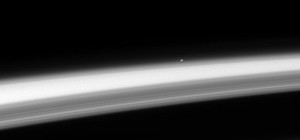
At present the various astrophysics subcommittees have got together with universities to make recommendations to the NASA Executive for consideration. In terms of telescopes, the main examples are a 10-12m UV, Visible and Near-Infrared “all rounder” telescope that is likely to be segmented like a big JWST and be fitted with high performance coronagraphs for exoplanet imaging (see below ). There is also a large, segmented Far-Infrared telescope like a direct descendent of JWST, an X-Ray telescope and a 4m “Habex” dedicated exoplanet telescope.
Image: Centauri A and B as captured by Cassini over the limb of Saturn. Credit: NASA/JPL.
Science definition groups are in the process of being formed to try and reach a consensus on what will be prioritised in the Decadal roadmap. All of these missions would be classed as “flagship” (multi-billion $), and if WFIRST does fly, as appears likely, the money for the 2020s will be spent before they arrive! This plan is thinking 15 years ahead. There is no guarantee that an exoplanet telescope will be selected, though interest in the field is burgeoning, with one third of papers submitted to journals last year on the topic. The presence of both a Far-Infrared telescope and an X-Ray telescope illustrates the influence some groups historically maintain. The two imaging missions are intertwined and illustrate the process of imaging exoplanets with internal occulters or “coronagraphs”.
The PIAA coronagraph, as usual, stands out in all domains barring average contrast reached. This device has a substantial heritage over the last decade in small exoplanet imaging concepts such as EXCEDE (Exoplanetary Circumstellar Environments and Disk Explorer), PECO (Pupil mapping Exoplanet Coronagraphic Observer) and most recently the Probe concept Exo-C, a smaller version of which ACEsat is based on. Simulations show how important “post processing” of the raw data received from the telescope is.
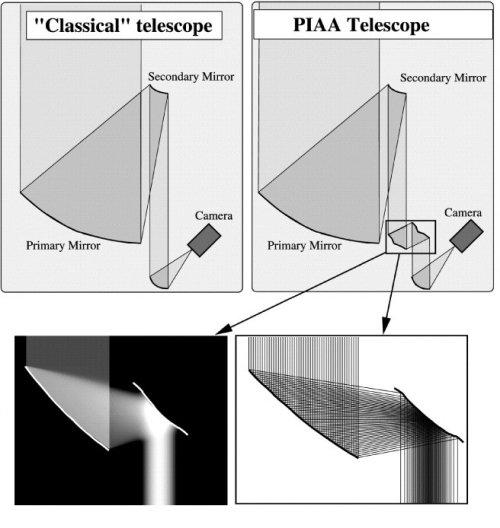
Image: An off axis telescope without and as ACEsat with a PIAA coronagraph. Credit: Wikimedia Commons.
Conventional methods will improve contrast by up to thirty times. This includes techniques that remove “speckles” or stray starlight within the telescope due to wavefront errors or mirror imperfections. “Angular differential imaging” removes these by rotating the image and subtracting it from the original non-rotated version. “Spectral differential imaging” takes advantage of subtle variations in the spectrum of reflected planet light. This will include the spectra of molecules in any atmosphere, which will be very different from back or foreground targets as well as exo-zodiacal light. Finally, when reflected off a planet, starlight tends to become more polarised, which differentiates it from the original starlight and background sources. Thus a polarimeter can separate out an exoplanetary signal. Ground-based telescopes used for exoplanet imaging, like the VLT, employ just such devices to run as part of an instrument package like SPHERE (Spectro-Polarimetric High-contrast Exoplanet REsearch) that also includes a coronagraph.
All of these methods are conventional and effective and, importantly, applied to the image after it has been taken or during the process of forming it. They are easy to do and don’t require multiple images. Compare this to the newest form of differential imaging, discussed below. These are ways of making the exoplanet stand out from the overall telescope field. That’s enough to take the telescope’s observations from “no image ” to “image”. The PIAA best contrast goes from just under 3×109 to 9×1011. In this case, that translates from seeing a large gas giant to seeing something Earth-sized. The post processing also takes some of the pressure of delivering contrast away from the coronagraph and its designers, too.
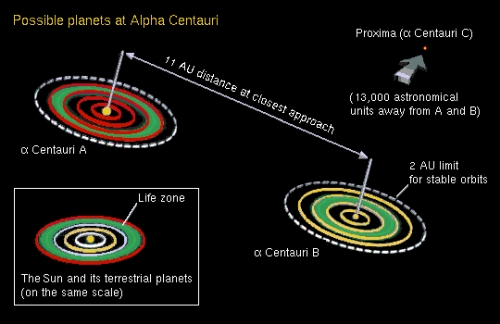
Image: Two habitable zones to work with in this close binary. What will we find around Centauri A and B?
How ACEsat Operates
ACEsat is a small, 45cm telescope, yet it can deliver contrasts down to 3×1011. How? Until recently there have been just two post processing techniques. The ACEsat team have cleverly created an additional technique called “Orbital differentiating imaging” (ODI). This uses an exoplanet’s orbit to identify it from the background “noise”. It is so potent that it is even resistant to exozodiacal light (dust from asteroids and comets that reflects light like planets, thus mimicking them — believed to be responsible for the “planet” seen shepherding the Fomalhaut protoplanetary disk) that can contaminate and ruin previous exoplanet imagery.
By way of comparison, ODI can improve contrast by a thousand times. The key is that to deliver ODI, one needs information on a good fraction of the exoplanet’s orbit. That’s why ACEsat had to take 2000 images of Alpha Centauri over a two year period, yet despite its size could deliver images AND spectroscopic characterisation. That approach requires a dedicated telescope, not the one year laid aside for WFIRST, though as can be seen, terrestrial planets could still be viewed — such is the potency of the PIAA versus other coronagraphs. The Hybrid Lyot coronagraph has been chosen for WFIRST so far as its average performance is better, and with limited time to justify inclusion, the coronagraph needs as many planets characterised as possible. Hence the list of known Exo-Jupiters that will dictate its use. Quantity over quality.
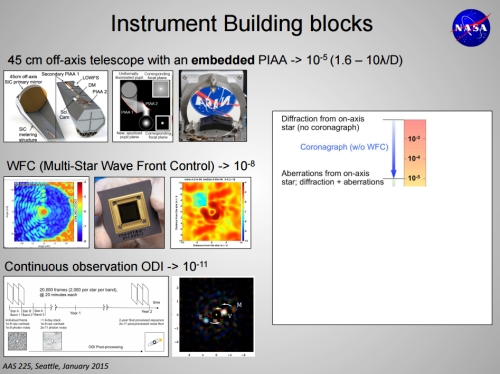
Image: From a presentation on ACEsat by Eduardo Bendek at AAS 2015 in Seattle, available online.
The other key feature of the PIAA is its “inner working angle” (IWA). This is the degree to which the parent starlight is compressed inwards as much as possible, concentrated by the PIAA, in order to create a dark disk around the star that will allow any exoplanets to stand out. The PIAA is the only coronagraph considered for WFIRST that has an IWA that would allow a planet in the habitable zone of a Sun-like star to be seen. The smaller the IWA the better. This also allows for smaller orbits, which of course require less time and images to determine, thus allowing ODI to come into play. The price for this precision is that the coronagraph is extremely sensitive to “jitter”, small unwanted movements caused by the steering reaction wheels, and thermal instabilities.
The WFIRST simulation data demonstrate how severe this can be and disruptive to successful exoplanet characterisation. It was because of thermal instabilities that silicon carbide was chosen as a construction material, as it is very stable to changes in temperature, defined by the “coefficient of thermal expansion”. Jitter is actively mitigated by the use of a “fast” tip/tilt mirror incorporated into the optical train that the coronagraph sits in, one that uses starlight rejected by the coronagraph to feed a computer that in turn controls the position of the mirror to correct any wavefront errors. Such is the importance of this part of the telescope that despite the presence of an on-board computer, “real time” modifications will still need to be made from the ground, all of which adds to the “operations costs” described later.
Wavefront errors arising from other sources are corrected in turn by an electromechanical, MEMS-deformable mirror (DM), also in the optical train and also feeding a guiding computer. The equivalent of active optics in a ground-based telescope. Imperfections in the telescope mirror can allow stray starlight in the firm of “speckles ” that can be removed this way.
Working with a Close Binary
With ACEsat, which is in the unusual situation of imaging a close binary system where light from one star will seep into planetary imaging of its neighbour, deformable mirrors managed by a “multi-star wavefront control” computer algorithm counteract this and in doing so open the door to imaging planets around the many binary systems close to the Solar System. All of these will reduce the telescope’s overall throughput, which demonstrates why it is so important not to throw away light in the coronagraph given there is so little to start with. Other conventional glass mirrors also possess such properties, but for a small telescope are prohibitively expensive and heavy. The initial ACEsat bid had the telescope in an “Earth trailing orbit”, drifting away at 0.2 AU per year but in a thermally stable, easy (cheap) orbit in direct contact with Earth. Traditionally such missions utilise the superior but more difficult to reach Earth/Sun Lagrange 2 point. Trade offs are a necessity when funds are low.
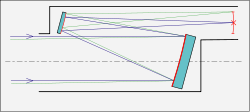
The other issue is the amount of light the coronagraph allows through to the all important spectrograph. ACEsat is an off-axis telescope in that its mirror is offset to focus its light to a point outside the telescope, so that there is no obstructive secondary mirror or coronagraph to waste precious incident light (up to 20% is obstructed in on-axis telescopes). The coronagraph thus runs down the side of the telescope and is actually embedded into it, which is possible with a smaller telescope with a less complicated mirror arrangement in its coronagraph, and embedding helps significantly reduce the damaging “jitter” described above.
Image: A simple illustration that illustrates the off-axis concept. Here the red line is the focal plane where spectrograph, imaging camera, polarimeter etc are located. Credit: Wikimedia Commons / Ashley Baldwin.
Inside the PIAA Coronagraph
The PIAA is the only coronagraph with near 100% throughput, thus allowing all light delivered by the telescope for characterisation in the spectrograph at the end of the “optical” train. The importance of this is that spectrographs unavoidably have considerably less than 100% throughput while some coronagraphs have only 20% throughput! A PIAA coronagraph in essence uses two sets of “aspheric” (curved at edges) mirrors to concentrate the Point Spread Function (PSF), or disk of light produced by a telescope when it images a point light source like a star. It removes the sharp diffraction rings that surround the central disk to create a dark area where reflected planetary light can be seen. In essence, the central starlight is slowed down whilst the extreme edge is allowed as normal, leaving a dark area around the edges.
A simple “stop” blocks off the Gaussian-like “peak” of starlight, creating a dark starlight-free zone around the PSF in which, with suitable contrast and light, an exoplanet image can be seen. The PIAA is unique amongst coronagraphs in allowing through most of the planet light, which is vital when one thinks just how faint this is. Up to ten billion times less than the star in the visible spectrum, though less as wavelengths increase into the infrared, which allows for lower imaging contrast but at the price of image resolution, which is derived from wavelength/telescope aperture.
ACEsat takes advantage of the PIAA design to actually embed it around the telescope secondary and tertiary mirrors, which feed the concentrated PSF starlight to an occulter at the first focal plane, where most of it is blocked and some is redirected to a computer that controls the deformable mirror “upstream” that then corrects any wavefront errors. This process helps create the dark area surrounding the central PSF described above, allowing planet light to pass unhindered through the optical train to the final focal point, and imaging via electron magnifying CCD (EMCCD) cooled to minus 85° C. This cooling prevents “dark current”, electrical current arising spontaneously within the pixels of the sensor array and causing them to activate in the absence of genuine photon stimulation.
The EMCCD sensor is now standard for visible imaging, with its individual pixels (1024×1024) releasing additional electrons when stimulated by a light photon in order to boost the final image/signal. The embedding of the PIAA around the telescope mirrors IWA unique design features that are only practical in smaller telescopes but do increase the telescope stability many fold. It is impossible to overstate just how important telescope stability is when imaging faint light sources light years away. Despite a “vibration source isolation system” that separates the telescope from its bus and its 23 fine-pointing reaction wheels, the transfer of some vibration or “jitter” is unavoidable, as is some degree of thermal instability, and this needs to be controlled to within 0.5 milli-arc seconds by tip/tilt mirror and related computer for a successful image to be formed.
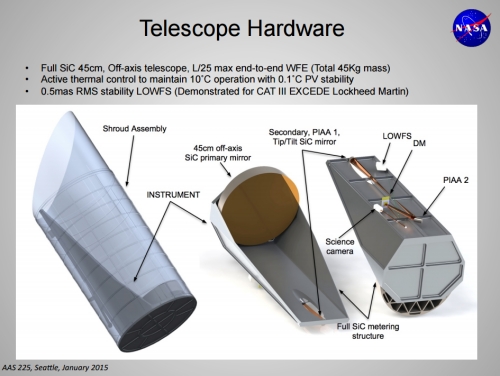
Image: ACEsat hardware, from Eduardo Bendek’s presentation at AAS 2015.
The PIAA’s small IWA, though helpful in allowing planets to be imaged as near to the stars as possible, also increases the telescope’s sensitivity to jitter. The larger and more sensitive the scope, the greater this sensitivity. ACEsat is ahead of its time because of its small size, allowing greater stability. This approach is so far only possible up to 1.5m and the main drawback is that, although the planets can be characterised in terms of mass and orbit, detailed spectroscopic analysis, looking for atmospheric constituents for instance, is not possible. The larger versions simply allowing a wider radius of imaging. Even the 45 cm version of ACEsat was intended for an extended mission to image Sirius, Procyon and Altair, with the latter as far out as 16 light years. All of these are either genuine or visual binaries with a bright member, so fitting in well with ACEsat’s imaging strategy.
ACEsat clearly illustrates the incredible precision that would be needed on the kind of multi-metre aperture telescopes that would have the light gathering sensitivity to spectroscopically analyse exoplanets. What it does do, though, is introduce the new and potent orbital differentiating post-processing technique that could work just as well or indeed better with larger telescopes, whilst taking some of the contrast role off of the coronagraph. The need for prolonged imaging to obtain as much of an exoplanetary orbit as possible is evident, which requires dedication. ACEsat proposed observation periods run of up to 100 days at a time.
A Future for ACEsat?
There is clear synergy between ACEsat and WFIRST in that the ongoing research on the latter will improve the PIAA coronagraph further. The complex internal architecture of the National Reconnaissance Office (NRO) array that forms WFIRST is such that it effectively makes the telescope segmented, thus providing a comparison of a monolithic telescope versus the segmented design. If the hybrid Lyot remains the coronagraph of choice for WFIRST, should a revised version of ACEsat become reality then there will be opportunity to compare coronagraphs in the field and not just in the lab. The ACEsat design itself is a smaller version of the Exo-C Probe concept telescope that arose from NASA’s desire to look at exoplanet alternatives to WFIRST. As it is likely that any large space telescope of the future will be equipped with high performance coronagraphs, both WFIRST and ACEsat present perfect test beds.
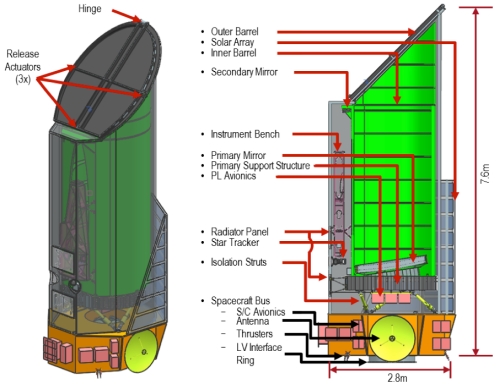
Image: The monolithic 1.5m off axis Exo-C telescope that is near identical to the biggest version of ACEsat. The only difference is it uses a Hybrid Lyot coronagraph instead of a PIAA and it isn’t embedded in the telescope wall. Otherwise, this is a good representation of a big ACEsat or indeed any unobstructed coronagraph exoplanet imager. Image credit: Exo-C Concept Development page / JPL.
ACEsat was unsuccessful for its SMEX bid. Its design is robust and its construction material, silicon carbide composite, which is used for the entire satellite, has an extensive and successful heritage in Europe. The mission objective was purely Alpha Centauri, so if nothing was discovered for any reason, then the funding is wasted as the telescope at just 45cm was bespoke for our nearest stellar neighbour. It will interesting to see what modifications any funding resubmission has. For one, it is likely to be larger to allow characterisation of more than one star system and not have “all its eggs in one basket”. The design can be extrapolated to at least a 1.5m aperture with eighty times the light gathering of the original ACEsat and more than three times the resolution. This should allow a planets as far out as thirty light years to be imaged over the extended period only a dedicated telescope can provide.
The question is just how much bigger the available funding would allow this telescope to become. The now familiar Dawn mission was cancelled/postponed on several occasions amidst a NASA funding crisis but subsequently reinstated when it’s manufacturers, Orbital Sciences Corporation, agreed to build it at “cost”, so confident were they in the ability of its innovative design to deliver. A decision that more than paid off with great science and publicity.
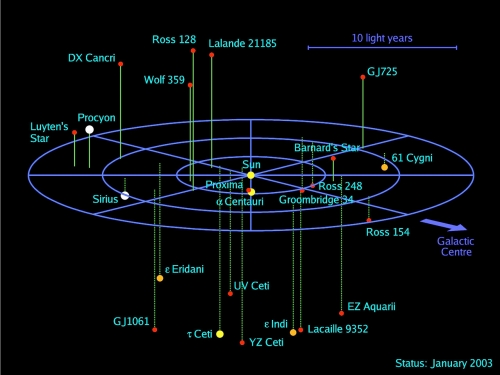
Image: Potential targets for an expanded ACEsat. Credit: ESO.
It’s worth mentioning that an 80m ground based ELT, based in optical viewing conditions on the Antarctic domes, could be expected to characterise 40 of the nearest Earth-like planets. An enhanced ACEsat of, say, 1.5m stands respectable comparison to this and illustrates the huge advantage of imaging above the atmosphere. And at a fraction of the cost.
The only question that leaves unanswered is, “how big”? The largest funding pool available for such missions is the Explorers programme of TESS fame. It is about $200 million with facility to top up with any savings made on using a smaller than expected launcher – a distinct possibility for a small telescope made from ultra light material. Silicon carbide is 5-10 times less heavy than conventional materials and equivalently cheaper. Capping mission time to, say, just two years is a gamble that releases funds from mission operations and systems engineering (running costs !) into the telescope proper, on the assumption that even in this shorter time enough high quality science will be delivered to justify a significant extension. Consumables (fuel etc) reflect this by being far more than is necessary for the primary mission. If sensitive spectrographs like ESPRESSO come on line in the next two years, their precision work will provide a list of nearby targets to reduce exoplanet search times within previous mission time. The TESS spacecraft bus has a life expectancy of up to seven years or more despite a two year primary mission.
There will be no additional funds for exoplanet imaging next decade. If “ACEsat plus” is approved, that will be two exoplanet imaging missions to supplement PLATO and the ELTs, preparing hopefully for the big telescopes of the next decade. It may not be the USS Enterprise, but an enlarged ACEsat telescope would enable man to boldly go where no man has been before. Unlike a manned spacecraft, its ingenious design and novel construction material, silicon carbide, will cost a small fraction of conventional telescopes and fit within pre-existing funding envelopes. Its coronagraph, sophisticated wavefront control and processing algorithms will allow imaging of our nearest stellar neighbours and open up a whole new investigation area in binary systems.
By far and away the most exciting goal is looking for planets in the habitable zone of the two sun analogues of the Alpha Centauri system. In doing so it will be years ahead of its time, dovetail with the small exoplanet technology demonstrator element of WFIRST and be the forerunner of the large telescopes to come. A tremendous achievement if Ames and Northrop Grumman can pull it off. Dawn of a new age?
We live in interesting times. Parlous financial circumstances have not stopped the eighteen month placement of a lunar UV telescope by a Chinese team, while India is launching an X-ray telescope. Things are moving forward fast. The question is, just how far are this US team prepared to go to achieve their visionary goal and maintain an obvious technological lead? Success could lead to the first habitable exoplanet or at least a terrestrial planet in a habitable zone, so the rewards are potentially huge, while the costs are low.
——-
Further Reading
“From Cosmic birth to living Earths: A visionary space telescope for UV-Optical-Near IR Astronomy”: AURA, 2015. http://www.hdstvision.org/report/
“How to directly image a habitable planet around Alpha Centauri with a 30-45cm telescope”: AAS Belikov et al., 2015. http://arxiv.org/abs/1510.02479
“Space mission and instrument design to image the habitable zone of Alpha Centauri”: Bendek et al 2015. http://adsabs.harvard.edu/abs/2015AAS…22531102B
“The orbital design of Alpha Centauri Exoplanet Satellite (ACEsat) Heliocentric orbit design: Interplanetary small satellite conference, Beyond LEO”: Weston et al 2015. http://digitalcommons.usu.edu/cgi/viewcontent.cgi?article=3228&context=smallsat
WFIRST-AFTA, STDT final report: Spergel et al 2013. http://wfirst.gsfc.nasa.gov/science/sdt_public/WFIRST-AFTA_SDT_Final_Report_Rev1_130523.pdf
“The search for habitable worlds 1: The viability of a star shade mission”: Turnbull et al, 2012. http://arxiv.org/abs/1204.6063
“Design study of an 8m monolithic mirror UV/Optical space telescope”: H Philip Stahl 2009. http://www.stsci.edu/institute/atlast/documents/stahl_8mDesign_SPIE2008.pdf
“WFIRST-AFTA Coronagraph instrument low order wavefront sensing and control”: Shi et al, JPL Cal Tech, 2014. http://home.strw.leidenuniv.nl/~kenworthy/_media/nospeckles:shi-afta-c_lowfsc.pdf
“The phase induced amplitude Apodization coronagraph”: Guyon et al, 2006. http://exep.jpl.nasa.gov/TPF/Coronagraph_PDFs/CWP2006_31_Guyon_pp157-161.pdf
“High contrast imaging and wavefront control with a PIAA coronagraph: Laboratory system validation”: Guyon et al 2009. http://arxiv.org/abs/0911.1307
“Low order wavefront sensing and control and Point Spread Function calibration for direct imaging of exoplanets”: JPL presentation : Guyon and Traub 2014. http://exep.jpl.nasa.gov/exopag/exopag10/presentations/Guyon_ExoPAG10_LOWFS.pdf

Kepler: A New Look at False Positives
Oh to be in Hawaii for the Extreme Solar Systems III conference rather than simply following events on Twitter! The exoplanet community’s choice of venues for these gatherings is hard to beat, the first of them, in 2007, having occurred on Santorini, a storied island in the Aegean Sea southeast of the Greek mainland, with a 2011 follow-up in Jackson Hole, WY. If you haven’t been following events on Twitter (#ExSS3), you can at least check the full program with abstracts online, where you’ll see quite a few familiar names.
Alexandre Santerne’s session at ExSS3 is one I wish I could have sat in on yesterday. Leading an international team, Santerne (Instituto de Astrofísica e Ciências do Espaço, Portugal) has gone to work on Kepler detections of gas giants. You would think that planets of this size would be fairly straightforward detections, but it turns out that this is not the case. In fact, Santerne and team find that half of the giant exoplanet candidates are false positives.
To be specific, the group’s five-year radial velocity study of these candidate worlds using the SOPHIE spectrograph reveals that 52.3 percent are actually eclipsing binaries, while 2.3 percent are brown dwarfs. An eclipsing binary simply involves a binary star system aligned so that the larger star can eclipse the smaller and the smaller can transit the larger’s disk. Eclipsing binaries are a known issue in exoplanet detection but I don’t think anyone believed the false positive rate could be this high. Says Santerne:
“It was thought that the reliability of the Kepler exoplanets detection was very good – between 10 and 20% of them were not planets. Our extensive spectroscopic survey, of the largest exoplanets discovered by Kepler, shows that this percentage is much higher, even above 50%. This has strong implications in our understanding of the exoplanet population in the Kepler field.”

Image: This artist’s view shows the hot Jupiter exoplanet 51 Pegasi b, which orbits a star about 50 light-years from Earth in the constellation of Pegasus. This was the first exoplanet around a normal star to be found, in 1995. Twenty years later this object was also the first exoplanet to be be directly detected spectroscopically in visible light. Credit: ESO/M. Kornmesser/Nick Risinger (skysurvey.org).
The research reduced the 8826 objects on the list of Kepler objects of interest (KOI) down to 129 KOIs by removing known false positives, candidates with orbits of more than 400 days (where fewer than three transits could be observed) and stars that the SOPHIE instrument found too faint to work with. Installed on the 1.93 meter telescope of the Observatory of Haute-Provence, SOPHIE (Spectrographe pour l’Observation des Phénomènes des Intérieurs stellaires et des Exoplanètes) is capable of measuring radial velocities of 2 meters per second.
With a hard 129 KOIs chosen as its defined sample, the team then went to work on the remnant. These KOIs all showed a transit depth between 0.4% and 3% and a period of up to 400 days. The method was to perform a radial velocity follow-up on these candidates using SOPHIE during six observing seasons. The paper describes the result:
…we found that 45 bona-fide planets (30 already known and 15 new ones characterised by our team), 3 sub-stellar companions that are likely brown dwarfs, 63 multiple stellar systems… out of which 48 are eclipsing binaries and 15 are more complex stellar systems. Finally, for 18 objects, we rejected that they are grazing EBs or brown dwarfs, but we could not establish their planetary nature. For these, we were able to put an upper-limit on their mass.
The false positive rate turns out to be significantly higher than previous values, and the paper argues that the absolute number of false positives is expected to grow as we look at planet candidates with a smaller radius. It’s interesting to see in the results that the occurrence rate of ‘hot Jupiters’ is lower by a factor of 2 compared with other surveys. This lower occurrence rate is not found for gas giants with orbital periods longer than 85 days, leading the authors to speculate that there may be mechanisms of ‘hot Jupiter’ formation specific only to them.

Image: Selected population of planet candidates detected by the Kepler Space Telescope. Their transit depth is displayed here as a function of their orbital period. The size of the marker is relative to the magnitude of the host. Credit: Santerne et al.
We always knew that finding exoplanets, much less characterizing them, was an exceedingly fine-grained task, but these results tell us that even the largest planets, and presumably the easiest to detect, present their own set of problems. The importance of radial velocity follow-ups is clear given the numerous sources of noise in the data. The paper goes on to discuss what may be a connection between the density of moderately irradiated giant planets and the metallicity of their host stars, but the authors say that the correlation needs to be confirmed with more planets in this category.
The paper is Santerne et al., “SOPHIE velocimetry of Kepler transit candidates XVII. The physical properties of giant exoplanets within 400 days of period,” accepted at Astronomy & Astrophysics (preprint).

A Thoroughly Disrupted Solar System
A quick follow-up on our most recent discussion of KIC 8462852 (and thanks to all for the continuing high level of discussion in the comments) because today’s topic touches on a bit of the same ground. Centauri Dreams regular Harry Ray was first to notice a paper from Eva Bodman and Alice Quillen (University of Rochester) titled “KIC 8462852: Transit of a Large Comet Family.” From the paper:
…if the comet family model is correct, there is likely a planetary companion forming sungrazers. Since the comets are still tightly clustered within each dip, a disruption event likely occurred recently within orbit, like tidal disruption by the star. This comet family model does not explain the large dip observed around day 800 and treats it as unrelated to the ones starting at day 1500. The flux changes too smoothly and too slowly to be easily explained with a simple comet family model.
I’ve only had the chance to glance at this work so far, but it’s heartening to see another paper analyzing the KIC 8462852 light curves. Massimo Marengo (Iowa State), whose own paper we just looked at, notes in the comments to that article that star-grazing comets regularly fragment, and to produce a ‘family of comets’ at KIC 8462852 simply requires a large, icy body (think, for example, of a Kuiper Belt object) breaking up after a close pass by the star. The follow-up work that Marengo, Hulsebus and Willis recommend in their paper give us a useful way to proceed.
Addendum: Dr. Marengo just alerted me to another new paper, one in which he had a hand. It’s Lisse et al., “IRTF/SPEX Observations of the Unusual Kepler Lightcurve System KIC8462852,” now available here on the arXiv site. From the abstract, this interesting bit:
Our results are inconsistent with large amounts of static close-in obscuring material or the unusual behavior of a YSO system, but are consistent with the favored episodic models of a Gyr old stellar system favored by Boyajian et al. (2015). We speculate that KIC8462852, like the ~1.4 Gyr old F2V system ? Corvi (Wyatt et al. 2005, Chen et al. 2006, Lisse et al. 2012), is undergoing a Late Heavy Bombardment, but is only in its very early stages.
Exoplanets at System’s Edge

The thought of comets on interesting courses provides a helpful segue into today’s topic, a study by Paul Kalas (UC-Berkeley) and colleagues that looks at the star HD 106906, where images from the Gemini Planet Imager and new analysis of data from the Hubble instrument show us a cometary belt that is lopsided. The disturbed nature of this solar system is obvious, telling us of likely planetary interactions that caused the comet disruptions and may well have caused an exoplanet seen in the GPI image to be driven to the remote outskirts of its system.
Image: Astrophysicist Paul Kalas. Credit: UC Berkeley.
We may be looking at disruptions caused by a passing star, although the researchers do not rule out a second massive planet as the culprit in the HD 106906 system. The planet HD 106906 b was discovered by Vanessa Bailey (University of Arizona) in 2014, a gas giant of approximately eleven times Jupiter’s mass. 300 light years from us in the constellation Crux, the young star (about 13 million years old) is separated from its companion by an eyebrow-raising 650 AU. This is sixteen times farther than Pluto is from the Sun, a region far beyond where planets are normally thought to form.
Image (click to enlarge): Two direct images of the cometary dust and exoplanet surrounding the young star HD 106906. The wider field in blue shows Hubble Space Telescope data where the star’s blinding light is artificially eclipsed (gray circular mask). The point to the upper right is an 11 Jupiter mass planet located over 650 times the Earth-Sun distance. A new discovery in these Hubble observations is an extremely asymmetric nebulosity indicating a dynamically disturbed system of comets. Surprisingly, the planet is located 21 degrees above the plane of the nebulosity. The circular orange inset shows a region much closer to the star that can only be detected using advanced adaptive optics from the ground-based Gemini Observatory. Using the Gemini Planet Imager (GPI), researchers found a narrow loop of nebulosity suggesting that a planetary system formed close to the star, but somehow the architecture of the outer regions is severely disrupted. Credit: Paul Kalas / UC Berkeley.
Several explanations for the location of this planet can be advanced, one of them being that the planet formed where it is today from its own cloud of gas and dust, but the Kalas paper looks at the options involving system disruption. For archival images from Hubble’s Advanced Camera for Surveys show us that HD 106906 is surrounded by a ring of material reminiscent of our own Kuiper Belt, with a largely empty central region, about 50 AU in radius, that implies a planetary system has formed there.
The outer ring, however, extends further than expected and is lopsided, reaching almost out to the known planet on one side, while being thick and truncated on the side opposite the planet. Moreover, the planet’s orbit appears to be tilted 21 degrees away from the plane of the inner system. “These discoveries,” said Kalas, “suggest that the entire planetary system has been recently jostled by an unknown perturbation to its current asymmetric state.”
In a UC Berkeley news release, Kalas adds this:
“We think that the planet itself could have captured material from the comet belt, and that the planet is surrounded by a large dust ring or dust shroud. We conducted three tests and found tentative evidence for a dust cloud, but the jury is still out.”
The paper analyzes three dynamical scenarios, two of which link the planet with the large-scale disk asymmetry, while the third assumes a stellar flyby that perturbed the disk, causing the asymmetry but not implicating the planet in its formation. If the planet is surrounded by a dust shroud or ring, this along with the misshapen debris belt would point to a planet that formed in the inner system and experienced gravitational interactions that forced it into the present outer orbit, as opposed to a planet that formed in that remote region in the first place.
Focusing in on dust near the planet, Kalas and colleagues conducted several experiments in their search for evidence of a circumplanetary disk. From the paper:
Based on the combination of evidence from the IR color, HST optical radial profile, and the optical flux level, we conclude that there may be a disk of material that was either captured in an encounter with the primary star’s disk, or retained from the time of formation of the planetary mass companion. Additional observations are required to clarify these tentative conclusions about the environment surrounding HD 106906b.
So we have only tentative evidence for a dust cloud of captured material surrounding the planet, perhaps as a large dust ring, but the paper outlines follow-up observations that can clarify the situation. In any case, we are learning how violent a place a young solar system can be, with gravitational disturbances that can profoundly affect dust and debris disks and potentially eject entire planets from the inner system. A passing star could explain the initial disruption here. We now wait to learn how a possibly ejected planet further affects the system’s configuration.
The paper is Kalas et al., “Direct imaging of an asymmetric debris disk in the HD 106906 planetary system,” The Astrophysical Journal Vol. 814, No. 1 (2015). Abstract / preprint.

Habitable Planets in the Same System
Learning that our own Solar System has a configuration that is only one of many possible in the universe leads to a certain intellectual exhilaration. We can, for example, begin to ponder the problems of space travel and even interstellar missions within a new context. Are there planetary configurations that would produce a more serious incentive for interplanetary travel than others? What would happen if there were not one but two habitable planets in the same system, or perhaps orbiting different stars of a close binary pair like Centauri A and B?
My guess is that having a clearly habitable world — one whose continents could be made out through ground-based telescopes, and whose vegetation patterns would be obvious — as a near neighbor would produce a culture anxious to master spaceflight. Imagine the funding for manned interplanetary missions if we had a second green and blue world that was as reachable as Mars, one that obviously possessed life and perhaps even a civilization.
Solar systems with multiple habitable planets are the subject of an interesting new paper from Jason Steffen (UNLV) and Gongjie Li (Harvard-Smithsonian Center for Astrophysics), who point to the fact that the Kepler mission has found planet pairs on similar orbits, with orbital distances that in some cases differ by little more than 10 percent. Mars is at best 200 times as far away as the Moon, but as Steffen notes, multi-habitable systems will produce much closer destinations:
“It’s pretty intriguing to imagine a system where you have two Earth-like planets orbiting right next to each other,” says Steffen. “If some of these systems we’ve seen with Kepler were scaled up to the size of the Earth’s orbit, then the two planets would only be one-tenth of one astronomical unit apart at their closest approach. That’s only 40 times the distance to the Moon.”
We can’t know at this point whether any of the Kepler candidates have life or not, but consider this: Kepler-36, about 1530 light years away in the constellation Cygnus, is known to be orbited by a ‘super-Earth’ and a ‘mini-Neptune’ in orbits that differ by 0.013 AU. The outer planet orbits close enough to the inner that we can pick up obvious transit timing variations (TTV) for both. Locked in a 7:6 orbital resonance, these worlds are representative of this kind of planetary configuration. Imagine the changing celestial display from the surface of the super-Earth as the larger planet sweeps out its orbit. Now consider the same view if both planets were clearly habitable!

Image: A gas giant planet spanning three times more sky than the Moon as seen from the Earth looms over the molten landscape of Kepler-36b. Credit: Harvard-Smithsonian Center for Astrophysics.
Steffen and Li focus in on two key issues. Specifically, what sort of variations in obliquity might be caused by such close planetary orbits? Obliquity measures the angle between the planet’s spin and its orbital axis — Earth’s 23.5° tilt relative to its orbit explains seasonal change and has obvious effects on climate. So we’d like to know whether close orbits disrupt planetary climates enough to wreak climatic havoc. The answer in most cases is no. From the paper:
We found that obliquity variations are generally not affected by the close proximity of the planets in a multihabitable system. Also, obliquity variations of close pairs embedded in the solar system or of potentially habitable planets in a system with a close pair were not sufficient to significantly reduce the probability of having a stable climate. Only in cases where the inclination modal frequencies coincide with the planetary precession frequency did large obliquity variation arise.
With planets this close, however, an even larger question is whether life on one planet can influence the other. We have abundant evidence of rocks from Mars that have fallen to Earth, leading to the possibility that other planets could have delivered life-bearing materials here in the process called lithopanspermia. Much closer planets should be far more susceptible to this process. Clearly, the possibility exists for life branching out from the same roots, taking different evolutionary paths just as occurs on remote islands here on Earth.
The simulations used by Steffen and Li demonstrate that two Earth-like planets in orbits like those found around Kepler-36 would have a much greater opportunity for exchanging materials than planets do in our Solar System. The relative velocities of the planets — and thus the velocities of the ejected particles — would be much less than in the case of a transfer of materials from Mars to the Earth. Biological materials transferred by collision ejecta have been considered on individual planets (with material falling back onto other parts of the same world), between binary planets or habitable moons, and even between different star systems.
Steffen and Li’s simulations show that the nearer the planets are to each other, the higher the success rate of ejecta transfer. Moving biological materials between two worlds becomes almost as feasible as moving them from one place on a single planet to another region of that planet, and the energy of the impact needed to make the transfer is much less than in our Solar System, leading to higher survivability. We can add in the fact that the time needed for biological materials to survive an interplanetary journey is that much shorter.
And there is this final factor:
…we found that the smaller the velocity of the ejected material the more uniformly they can be sourced across the originating planet. With high velocity ejecta, the range of initial longitudes is constrained relative to the direction of motion.
The result: Debris from a single impact is far more likely to strike the destination planet at multiple locations in rapid succession than when planets are spaced farther apart. That too increases the chance of life catching hold. Processes like these, which could also occur around planets with large habitable moons, allow life to spread readily within the same system. The paper adds:
Not only will panspermia be more common in a multihabitable system than in the solar system, but the close proximity of the planets to each other within the habitable zone of the host star allows for a real possibility of the planets having regions of similar climate—perhaps allowing the microbiological family tree to extend across the system. There are many things to consider in multihabitable systems, especially in the cases where intelligent life emerges.
In this UNLV news release, Steffen follows up that last thought:
“You can imagine that if civilizations did arise on both planets, they could communicate with each other for hundreds of years before they ever met face-to-face. It’s certainly food for thought.”
The scenario is striking, and I’m hoping readers can come up with some science fiction titles in which multiple habitable planets in the same system are the background for the tale.
The paper is Steffen and Li, “Dynamical considerations for life in multihabitable planetary systems,” accepted at The Astrophysical Journal (preprint).

No Catastrophic Collision at KIC 8462852
Last week I mentioned that I wanted to get into Massimo Marengo’s new paper on KIC 8462852, the interesting star that, when studied by the Kepler instrument, revealed an intriguing light curve. I’ve written this object up numerous times now, so if you’re coming into the discussion for the first time, plug KIC 8462852 into the archive search engine to get up to speed. Marengo (Iowa State) is himself well represented in the archives. In fact, I began writing about him back in 2005, when he was working on planetary companions to Epsilon Eridani.
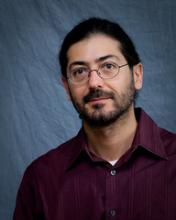
In the new paper, Marengo moves the ball forward in our quest to understand why the star I’ll abbreviate as KIC 8462 poses such problems. The F3-class star doesn’t give us the infrared signature we’d expect from a debris disk, yet the light curves we see suggest objects of various sizes (and shapes) transiting across its surface. What we lacked from Tabetha Boyajian’s earlier paper (and it was Boyajian, working with the Planet Hunters group, that brought KIC 8462 to our attention) was data about infrared wavelengths after the WISE mission finished its work.
That was a significant omission, because the WISE data on the star were taken in 2010, while the first events Kepler flagged at KIC 8462 occurred in March of 2011, with a long series of events beginning in February of 2013 and lasting sixty days. That gave us a small window in which something could have happened — the idea of a planetary catastrophe comes to mind, perhaps even a collision between two planets, or a planet and large asteroid. What Marengo brings to the table are observations from the Spitzer Space Telescope dating from early 2015.
Image: Astrophysicist Massimo Marengo. Credit: Iowa State University.
We learn that the Spitzer photometry from its Infrared Array Camera (IRAC) finds no strong infrared excess — no significant amount of circumstellar dust can be detected two years after the 2013 dimming event at KIC 8462. Here is what Marengo concludes from this:
The absence of strong infrared excess at the time of the IRAC observations (after the dimming events) implied by our 4.5 µm 3? limit suggests that the phenomenon observed by Kepler produced a very small amount of dust. Alternatively, if significant quantity of dust is present, it must be located at large distance from the star.
This seems to preclude catastrophic scenarios, while leaving a cometary solution intact. The paper continues:
As noted by B15 [this is the Boyajian paper], this makes the scenarios very unlikely in which the dimming events are caused by a catastrophic collision in KIC 8462852 asteroid belt, a giant impact disrupting a planet in the system, or a population of dust-enshrouded planetesimals. All these scenarios would produce very large amount of dust dispersed along the orbits of the debris, resulting in more mid-IR emission than what can be inferred from the optical depth of the dust seen passing along our line of sight to the star. Our limit (two times lower than the limit based on WISE data) further reduces the odds for these scenarios.

Image: Montage of flux time series for KIC 8462852 showing different portions of the 4-year Kepler observations with different vertical scalings. Panel ‘(c)’ is a blowup of the dip near day 793, (D800). The remaining three panels, ‘(d)’, ‘(e)’, and ‘(f)’, explore the dips which occur during the 90-day interval from day 1490 to day 1580 (D1500). Credit: Boyajian et al., 2015.
Tabetha Boyajian’s paper analyzed the natural phenomena that could account for KIC 8462’s light curve and concluded that a family of exocomets was the most promising explanation. Here the idea is that we have a family of comets in a highly elliptical orbit that has moved between us and the star, an idea that would be consistent with the lack of a strong infrared signature. Marengo has reached the same conclusion now that we are able to discount the idea of a large collision within the system. Both Boyajian and Marengo favor the comet hypothesis because it does not require a circular orbit and allows associated dust to quickly move away from the star.
In Marengo’s analysis, this fits the data, as the two-year gap between the Kepler light curves and the observations from Spitzer provide enough time for cometary debris to move several AU from the zone of tidal destruction from the star. The paper adds:
At such a distance, the thermal emission from the dust would be peaked at longer wavelengths and undetectable by IRAC. A robust detection at longer wavelengths (where the fractional brightness of the debris with respect to the star would be more favorable) will allow the determination of the distance of the cometary fragments and constrain the geometry of this scenario.
So we have a way to proceed here. Marengo notes that the measurements his paper presents cannot reveal the temperature or the luminosity of the dust that would be associated with such a family of comets, but long-term infrared monitoring would allow us to constrain both. The other day I also mentioned the small red dwarf (about 850 AU out) that could be the cause of instabilities in any Oort Cloud-like collection of comets around KIC 8462. Boyajian’s paper makes the case for measuring the motion or possible orbit (if bound) of this star as a way to tighten predictions on the timescale and repeatability of any associated comet showers.
Marengo dismisses SETI study of KIC 8462, with specific reference to Jason Wright’s recent paper on the matter, as “wild speculations,” an unfortunate phrase because Wright’s shrewd and analytical discussion of these matters has been anything but ‘wild.’
The Marengo paper is Marengo, Hulsebus and Willis, “KIC 8462852 – The Infrared Flux,” Astrophysical Journal Letters, Vol. 814, No. 1 (abstract / preprint). The Boyajian paper is Boyajian et al., “Planet Hunters X. KIC 8462852 – Where’s the flux?” submitted to Monthly Notices of the Royal Astronomical Society (preprint). The Jason Wright paper that examines KIC 8462 in the context of SETI signatures is Wright et al., “The ? Search for Extraterrestrial Civilizations with Large Energy Supplies. IV. The Signatures and Information Content of Transiting Megastructures,” submitted to The Astrophysical Journal (preprint).

Will We Stop at Mars?
In the heady days of Apollo, Mars by 2000 looked entirely feasible. Now we’re talking about the 2030s for manned exploration, and even that target seems to keep receding. In the review that follows, Michael Michaud looks at Louis Friedman’s new book on human spaceflight, which advocates Mars landings but cedes more distant targets to robotics. So how do we reconcile ambitions for human expansion beyond Mars with political and economic constraints? A career diplomat whose service included postings as Counselor for Science, Technology and Environment at U.S. embassies in Paris and Tokyo, and Director of the State Department’s Office of Advanced Technology, Michael is also the author of Contact with Alien Civilizations (Copernicus, 2007). Here he places the debate over manned missions vs. robotics in context, and suggests a remedy for pessimism about an expansive future for Humankind.
by Michael A.G. Michaud
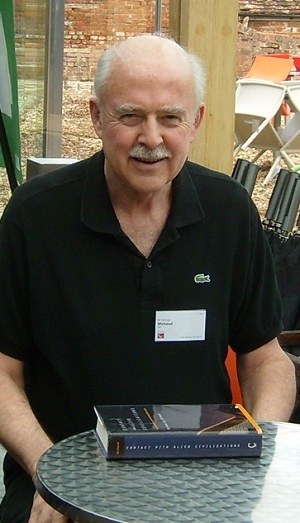
Many people in the space and astronomy communities will know of Louis Friedman, a tireless campaigner for planetary exploration and solar sailing. He was one of the co-founders of the Planetary Society in 1980, with Carl Sagan and Bruce Murray.
In his new book, entitled Human Spaceflight: From Mars to the Stars, Friedman states his argument up front: Humans will become a multi-planet species by going to Mars, but will never travel beyond that planet. Future humans will explore the rest of the universe vicariously through machines and virtual reality.
Friedman acknowledges that public interest in space exploration is still dominated by “human interest.” No one, he writes, is going to discontinue human spaceflight. Yet there is a conundrum. While giving up on manned missions to Mars is politically unacceptable, getting such a program approved and funded is not an achievable political step at this time. If another decade goes by without humans going farther in space, Friedman writes, public interest will likely decline and robotic and virtual exploration technologies will pass us by.
Friedman claims that going beyond Mars with humans is impossible not just physically for the foreseeable future but culturally forever. The long-range future of humankind, he declares, is to extend its presence in the universe virtually with robotic emissaries and artificial intelligence. This argument puts a permanent cap on human expansion, as if travel beyond Mars never will be possible.
Friedman sees having another world as a prudent step to prevent humankind being wiped out by a catastrophe. He argues that the danger of not sending humans to Mars is that we will become complacent. If that complacency overcomes making humankind a multi-planet species, we are doomed.
Friedman dismisses big ideas about exploiting planetary resources throughout the solar system and living everywhere to build civilizations and colonies on other worlds. He can’t see why or how we would do this, nor can he see waiting to do so. This illustrates an old split in the space interest community between those advocating space exploration and those supporting space utilization and eventual human expansion.
In his chapter entitled Stepping Stones to Mars, Friedman lists potential human spaceflight achievements with dates. An appendix presents a plan for a manned Mars mission in the 2040s. That first landing is to be followed later by missions establishing an infrastructure for human habitation, an effort that will take many decades.
Interstellar flight
This book’s subtitle is From Mars to the Stars. Yet Friedman dismisses interstellar travel by human beings as a subject of science fiction. People are too impatient, he writes, to wait for the necessary life-support developments. This contrasts with Carl Sagan’s 1966 comment that efficient interstellar spaceflight to the farthest reaches of our galaxy is a feasible objective for humanity.
Friedman argues that we have only one technology that might someday take our machines to the stars – light sailing. It may be another century before we have large enough laser power sources to drive small unmanned spacecraft over interstellar distances. The barrier of bigness will be overcome by the enablement of smallness.
Friedman suggests three interstellar precursor missions: the first launched in 2018 to the Kuiper Belt and onward to the heliopause; the second launched in 2025 to the solar gravity lens focus and on to 1,000 astronomical units; the third launched in 2040 to the Oort Cloud.
Virtual Reality
Friedman oversells virtual reality just as some others have oversold manned spaceflight. He acknowledges that we have yet to reach full cultural acceptance and satisfaction with the virtual world. Yet he seems to assume that such acceptance by the general population is inevitable.
Calling virtual reality human exploration may confuse many readers. Will we be content to watch all future exploration through robotic eyes?
There may be an unstated reason for preferring virtual reality over human presence. If future space exploration were entirely robotic, scientists would be in charge.
Cautions about Mars
Mars is far from ideal as a future home for humankind. The thin atmosphere is mostly carbon dioxide. Temperatures are low. The surface is more exposed to radiation and meteorites than Earth. Yet Mars remains the best candidate for a second planetary home within our own solar system.
Like other schedules proposed by some space advocates, Friedman’s plan for missions to Mars may be too optimistic. Yet such optimism keeps goals alive and encourages others to get involved.
What seems wildly optimistic now may be possible over the longer term. In the 1950s, some scientists thought that sending humans to the Moon was impossible.
The failure of grand visions
Friedman is correct in stating the biggest problem of space policy: the merging of grand visions with political constraints. In 1988, President Reagan’s statement on space policy included the idea of expanding human activity beyond Earth and into the solar system, an endorsement long sought by some elements of the space interest community. President George H.W. Bush fleshed out this idea in 1989 with his Space Exploration Initiative, urging that the U.S. develop a permanent presence on the Moon and the landing of a human crew on Mars by 2019. These visions failed to win the financing that would make them feasible.
Frustration and Patience
It is understandable that long-time campaigners for further exploration and use of space get frustrated, in some cases foreseeing the end of such endeavors. We all want to see major hopeful events occur in our own lifetimes. Yet we share some responsibility to look beyond.
Writing off human expansion beyond Mars for all the humans who follow us is, despite Friedman’s claim, pessimistic. The remedy is a younger generation of advocates.
A Little History
Friedman states that the settlement of Mars is the rationale for human spaceflight. The leaders of the Planetary Society did not initially support that goal. In the organization’s early years, its chief spokespersons criticized NASA’s emphasis on human missions (particularly the Space Station), which they saw as robbing funds that should have gone into further robotic exploration.
Sagan and others later realized that the planetary exploration budget rose and fell with the rise and fall of manned spaceflight programs. When NASA funding was rising, space science prospered; when NASA funding declined, space science funding declined with it. After the cancellation of further Apollo missions, planetary science was hit hardest by budget cuts . This revived a debate as old as the space program, between advocates of manned spaceflight and those who believe that priority should be given to exploration by unmanned spacecraft.
Friedman wrote in a 1984 article in Aerospace America about extending human civilization to space, suggesting a lunar base, a manned expedition to Mars, or a prospecting journey to some asteroids undertaken by an international team.
By the mid-1980s, the Planetary Society was advocating a joint U.S. Soviet manned mission to Mars. Senator Spark Matsunaga of Hawaii introduced legislation to support this idea and published a book in 1986 entitled The Mars Project: Journeys beyond the Cold War. Soviet leader Mikhail Gorbachev made overtures to the U.S. in 1987 and 1988 for a cooperative program eventually leading to a Mars landing.
Bruce Murray, reacting favorably to the 1989 Space Exploration Initiative, published an article in 1990 entitled Destination Mars—A Manifesto. Observing that the space frontier for the U.S. and the USSR had stagnated a few hundred miles up, Murray commented that neither the United States nor the Soviet Union is likely, by itself, to sustain the decades of effort necessary to reach Mars. Murray urged a joint U.S.-Soviet manned spaceflight program leading eventually to Mars.
This reviewer argued at the 1987 Case for Mars conference that relying on the Soviet Union during the Cold War made such a mission subject to political volatility. This turned out to be true. As Friedman reports, a brief flurry of interest by President Reagan and Gorbachev in a cooperative human mission to Mars disappeared quickly in the face of large global events such as the dissolution of the Soviet Union.
More recently, when the U.S. sought to punish Russia for invading Ukraine, Russian officials made public statements threatening the continuation of Russian transport of Americans to the International Space Station, even though the U.S. was paying for those flights.
References
Louis Friedman, Human Spaceflight: From Mars to the Stars, University of Arizona Press, 2015.
Louis D. Friedman, “New Era of Global Security: Reach for the Stars,” Aerospace America, August 1984, 4.
Michael A.G. Michaud, “Choosing partners for a manned mission to Mars,” Space Policy, February 1988, 12-18.
Chapter entitled “Scientists, Citizens, and Space” in Michael A.G. Michaud, Reaching for the High Frontier: The American Pro-Space Movement, 1972-1984, Praeger, 1986, 187-213.
Bruce Murray, “Destination Mars: A Manifesto,” Nature 345 (17 May 1990), 199-200.
Iosif Shklovskii and Carl Sagan, Intelligent Life in the Universe, Dell, 1966, 449.




